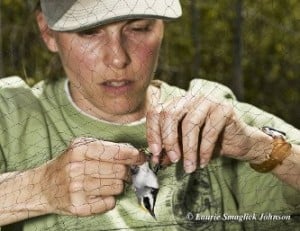Amber Roth was one of 12 nominees who were selected as the 2011 winners int he Notable Projects/Team Achievement category by the U.S. Department of the Interior, Fish and Wildlife Service. Amber was recognized for her work with Golden-winged Warbler Conservation in the Upper Midwest. Her work has contributed to landscape scale conservation not only in the Upper Midwest, but beyond. The project involves diverse agencies and institutions working together to achieve science-based conservation objectives and strategies.

Conservation could be Amber Roth’s middle name. She loves anything to do with nature. Birds, trees, grasses, ecosystems: she’s fascinated by it all.
So after tucking a BS in Conservation Biology and International Relations and an MS in Wildlife Ecology under her belt, the Green Bay, Wisconsin, native came to Tech to earn a PhD in Forest Science.
Roth researches how to manage aspen forests to produce the maximum amount of biomass per acre without harming wildlife habitat. But she was raised by a devoted bird-watcher, and a tiny songbird that is facing hard times has also captured her heart. She has become an active member of the Golden-winged Warbler Working Group, an international conservation organization that spans two continents.
Weighing only nine grams (equal to four dimes), the golden-winged warbler flies thousands of miles twice a year, migrating from its breeding grounds in the northern Midwest to its winter home in Central and South America. The tiny bird makes the long migration six to ten times in its lifetime.
“Its fuel efficiency is the equivalent of several hundred thousand miles per gallon,” Roth says with a smile.
But the far-flying warbler is in trouble. There used to be as many as half a million of the birds, and now there are fewer than two hundred thousand. “Its numbers are declining sharply, and we don’t know why. We don’t know where the patient is bleeding,” says Roth.
The Golden-winged Warbler Working Group received a small grant from the US Fish and Wildlife Service to try to determine what’s happening. Their research is a collaborative effort involving American, Canadian, and Latin American scientists.
They are spread thin. Some of the researchers are examining the bird’s, since they often crossbreed with blue-winged warblers. Only one genetically pure population has been found so far, in Manitoba. Others are studying the biochemical signature in the warbler’s feathers, which reveal where the young birds go after their first migration. And a third group is working to connect where the birds winter in Central and South America to where they breed.
“It’s a real skin-and-bones project,” says Roth. Michigan Tech has helped out by contributing twenty-one mist nets, used to safely capture birds for study before releasing them. And Roth helped the Natural Resources Foundation of Wisconsin raise $520 by leading field trips to her research sites in Wisconsin. The foundation donated the funds to the international warbler research group in late 2009.
Like most of the other things she’s ever done, Roth says her work with the Golden-winged Warbler Working Group is helping prepare her for her dream career. With work experience in the Wisconsin Department of Natural Resources and her PhD from Michigan Tech, she’s looking forward to climbing what she calls her “career triangle”: research, education, and conservation management. “I like being involved in all three,” she says, “the research, the outreach, and the management on the ground.